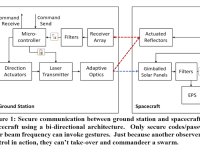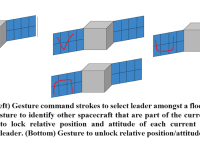The availability of high-performance Commercial Off-The-Shelf (COTS) electronics that can withstand Low Earth Orbit conditions has opened an avenue for wide deployment of CubeSats and small-satellites. Swarms of these small satellites offer whole new capabilities in Earth observation, global positioning and communication compared to a large monolithic spacecraft. These spacecraft can provide bigger apertures that increase gain in communication antennas, increase area coverage or effective resolution of distributed cameras and enable persistent observation of ground or space targets. However, there remain important challenges in operating large number of spacecrafts at once. Current methods require a large number of ground operators which poses challenges in terms of coordination and control and which prevents the technology from scaled up in cost-effective manner. Technologies are required to enable one ground operator to manage tens if not hundreds of spacecrafts or UAVs.
We propose to utilize laser beams directed from the ground or from a command and control spacecraft or UAV to securely organize and manage a large swarm (Illustration 1) . Each satellite or UAV in the swarm will have a customized “smart skin” containing solar panels, power/control circuitry and an embedded secondary propulsion unit. A secondary propulsion for spacecraft may include electrospray propulsion, solar radiation pressure-based system, photonic laser thrusters and Lorentz force thrusters. Solar panels typically occupy the largest surface area on an earth orbiting satellite and each solar cell will be used as a ‘pixel’ to identify ‘gesture strokes’ from an incoming laser signal. A laser beam from another spacecraft or from the ground would interact with solar panels of the spacecraft swarm with the right security codes (Illustration 2). The laser beam would be used to select a ‘leader’ amongst a group of spacecrafts set parameters for formation-flight, including separation distance, local if-then rules and coordinated changes in attitude and position in the form of ‘gestures.’
For formation flight, a leader spacecraft is selected using gestures and this is followed by identification of the remaining spacecraft in the group followed by locking the relative position of each spacecraft (Illustration 3) . After the group of spacecraft are locked in relative position and attitude, then gestures movements applied to the leader spacecraft will result in the remainder of the spacecraft following the leader in tandem, maintaining fixed distance and attitude. Finally, Illustration 3 (bottom) shows a gesture to unlock a spacecraft in terms of relative position and attitude from the group.
The laser beam will enable secure point to point communication and cannot be eavesdropped, unless if the eavesdropping unit is in the way or close to the derelict satellite. However, if RF (Radio Frequency) were to be used, then eavesdropping maybe possible without detection. RF signal requires licensing and is congested due to high demand. Use of a laser beam avoids these logistical challenges. This laser system may serve as a secure backup system that can be used to mitigate and take back control of a satellite from cybersecurity threats/hacking using RF communication.
Video
Like this entry?
-
About the Entrant
- Name:Jekan Thanga
- Type of entry:teamTeam members:Jekan Thanga, Himangshu Kalita, Leonard Vance, Vishnu Reddy
- Patent status:pending








